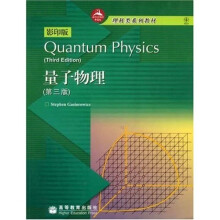理科类系列教材:量子物理(影印版)(第3版)

目 录内容简介
1. The Emergence of Quantum Physics 1
1-1 Blackbody Radiation 1
1-2 The Photoelectric Effect 5
1-3 The Compton Effect 7
1-4 Wave Properties of Matter and Electron Diffraction 10
1-5 The Bohr Atom 15
The Rutherford Planetary Model 15
The Bohr Postulates 15
The Correspondence Principle 20
Problems 21
SUPPLEMENTS ON THE WEB SITE:
1-.A Einsteins Approach to Plancks Law W-1
1-B Estimate of Lifetime of a Rutherford Atom W-4
2. Wave Particle Duality, Probability, and the Schrodinger Equation 23
2-1 Radiation as Particles, Electrons as Waves 23
2-2 Plane Waves and Wavepackets 25
*How Wave Packets Move 27
2-3 The Probability Interpretation of the Wave Function 28
2-4 The Schrtdinger Equation 30
2-5 The Heisenberg Uncertainty Relations 32
Diffraction of a Photon Beam 32
Inability to Localize Bohr Orbits 33
Interim Summary 34
2-6 More on the Probability Interpretation 34
The Importance of Phases 35
The Probability Current 35
2-7 Expectation Values and the Momentum in Wave Mechanics 36
The Momentum in Wave Mechanics 37
Wave Function in Momentum Space 38
Problems 41
SUPPLEMENTS ON THE WEB SITE:
2-A The Fourier Integral and Delta Functions W-6
2-B A Brief Tutorial on Probability W-11
3. Eigenvalues, Eigenfunctions, and the Expansion Postulate 44
3-1 The Time-Independent Schrtdinger Equation 44
3-2 Eigenvalue Equations 45
3-3 The Eigenvalue Problem for a Particle in a Box 47
3-4 The Expansion Postulate and Its Physical Interpretation 52
The Interpretation of the Expansion Coefficients 53
3-5 Momentum Eigenfunctions and the Free Particle 56
Normalization of the Free Particle Wave Function 57
Degeneracy 59
3 -6 Parity 60
Problems 63
4. One-Dimensional Potentials 66
4-1 The Potential Step 66
4-2 The Potential Well 69
4-3 The Potential Barrier 71
4-4 An Example of Tunneling 73
4-5 Bound States in a Potential Well 75
4-6 Deltas Function Potentials 81
4-7 The Harmonic Oscillator 85
Problems 90
SUPPLEMENTS ON THE WEB SITE:
4-A The Wentzel.Kramers-Brillouin-Jeffreys Approximation W-14
4-B Tunneling in Nuclear Physics W-16
4-C Periodic Potentials W-19
The Kronig-Penney Model W-21
5. The General Structure of Wave Mechanics 94
5-1 Eigenfunctions and Eigenvalues 94
The Hamiltonian Operator 94
5-2 Other Observables 96
The Interpretation of the Expansion Coefficients 97
5-3 Vector Spaces and Operators 98
5-4 Degeneracy and Simultaneous Observables 100
5-5 Time Dependence and the Classical Limit 103
Problems 105
SUPPLEMENT ON THE WEB SITE:
5-A Uncertainty Relations W-26
6. Operator Methods in Quantum Mechanics 107
6-1 Rephrasing Wave Mechanics——An Abstract View
of Quantum Mechanics 107
Projection Operators 111
6-2 The Energy Spectrum of the Harmonic Oscillator 112
6-3 From Operators Back to the Schrodinger Equation 114
6-4 The Time Dependence of Operators 116
Problems 117
7. Angular Momentum 120
7-1 The Angular Momentum Commutation Relations 121
7-2 Raising and Lowering Operators for Angular Momentum 122
7-3 Representation of I,m States in Spherical Coordinates 124
7-4 Comments on the Expansion Theorem 128
Problems 129
7-A Rotational lnvariance W-28
Invariance Under Rotations About the z.Axis W-28
7-B Angular Momentum in Spherical Coordinates W-30
8. The Schrodinger Equation in Three Dimensions
and the Hydrogen Atom 131
8-1 The Central Potential 132
8-2 The Hydrogen Atom 133
8-3 The Energy Spectrum 133
The Degeneracy of the Spectrum 135
8-4 The Free Particle 140
8-5 Particle in an Infinite Spherical Well 143
Problems
SUPPLEMENTS ON THE WEB SITE:
8-A A Useful Theorem W-35
8-B The Square Well, Continuum Solutions W-38
The Plane Wave Spherical Harmonics W-41
9. Matrix Representation of Operators 146
9-1 Matrices in Quantum Mechanics 146
9-2 Matrix Representations of Angular Momentum Operators 150
9-3 General Relations in Matrix Mechanics 151
Problems 156
10. Spin 158
10-1 Eigenstates of Spin 1/2 158
10-2 The Intrinsic Magnetic Moment of Spin 1/2 Particles 162
10-3 Paramagnetic Resonance 164
10-4 Addition of Two Spins 166
10-5 The Addition of Spin 1/2 and Orbital Angular Momentum 171
General Rules for Addition of Angular Momenta 171
Problems 172
SUPPLEMENTS ON THE WEB SITE:
1O-A The Addition of Spin 1/2 and Orbital Angular Momentum (Details) W-43
General Rules for Addition of Angular Momenta, and Implications
for Identical Particles W.44
10-B The Levi-Civita Symbol and Maxwells Equations W-47
11. Time-Independent Perturbation Theory 174
11-1 Energy Shifts and Perturbed Eigenstates 174
11-2 Degenerate Perturbation Theory 177
11-3 The Stark Effect 180
The Stark Effect for n = 2 States 182
Some Final Comments 184
Problems 185
12. The Real Hydrogen Atom 188
12-1 Relativistic Kinetic Energy Effects 188
12-2 Spin-Orbit Coupling 188
12-3 The Anomalous Zeeman Effect 191
12-4 Hyperfine Structure 194
12-5 Comments on Reduced Mass Effects 196
Problems 197
13. Many Partide Systems 199
13-1 The Two-Particle System 199
13-2 Identical Particles 201
The Exchange Operator 201
13-3 The Pauli Principle 202
N Fermions in a Potential Well 203
When Is Antisymmetrization Necessary? 204
13-4 The Exclusion Principle and the Two-Particle Problem 206
A Digression on Parity 206
13-5 The Exclusion Principle and Noninteracting Particles 207
13-6 Applications 211
Degeneracy Pressure and Bulk Modulus 211
Astrophysical Application 211
Problems 213
SUPPLEMENT ON THE WEB SITE:
13-A Conservation of Total Momentum W-49
14. About Atoms and Molecules 215
14-1 The Helium Atom without Electron-Electron Repulsion 215
Effects of the Exclusion Principle 217
14-2 Effects of Electron-Electron Repulsion 218
14-3 Exclusion Principle and Exchange Interaction 220
Autoionization 223
14-4 The Ritz Variational Principle 224
The Ground-State Energy of Helium 225
14-5 The Atom with Z Electrons 226
14-6 The Simplest Molecule H2+ 228
Molecular Orbitals 229
14-7 Molecular Spectra 231
The Role of the Pauli Principle in Molecular Spectra 232
Problems 233
SUPPLEMENTS ON THE WEB SITE:
14-A The Hartree Approximation W-51
14-B The Building-Up Principle W-55
Spectroscopic Description of Ground States W-58
14-C A Brief Discussion of Molecules W-64
The H2 Molecule W.64
The Valence Bond Method W-66
The Importance of Unpaired Valence Electrons W-67
15. Time-Dependent Perturbation Theory 236
16. The Interaction of Charged Particles with the Electromagnetic Field 246
17. Radiative Decays 260
18. Selected Topics on Radiation 270
19. Collision Theory 287
20. Entanglement and Its Implications 316
Physical Constants 329
References 330
Index 333
1-1 Blackbody Radiation 1
1-2 The Photoelectric Effect 5
1-3 The Compton Effect 7
1-4 Wave Properties of Matter and Electron Diffraction 10
1-5 The Bohr Atom 15
The Rutherford Planetary Model 15
The Bohr Postulates 15
The Correspondence Principle 20
Problems 21
SUPPLEMENTS ON THE WEB SITE:
1-.A Einsteins Approach to Plancks Law W-1
1-B Estimate of Lifetime of a Rutherford Atom W-4
2. Wave Particle Duality, Probability, and the Schrodinger Equation 23
2-1 Radiation as Particles, Electrons as Waves 23
2-2 Plane Waves and Wavepackets 25
*How Wave Packets Move 27
2-3 The Probability Interpretation of the Wave Function 28
2-4 The Schrtdinger Equation 30
2-5 The Heisenberg Uncertainty Relations 32
Diffraction of a Photon Beam 32
Inability to Localize Bohr Orbits 33
Interim Summary 34
2-6 More on the Probability Interpretation 34
The Importance of Phases 35
The Probability Current 35
2-7 Expectation Values and the Momentum in Wave Mechanics 36
The Momentum in Wave Mechanics 37
Wave Function in Momentum Space 38
Problems 41
SUPPLEMENTS ON THE WEB SITE:
2-A The Fourier Integral and Delta Functions W-6
2-B A Brief Tutorial on Probability W-11
3. Eigenvalues, Eigenfunctions, and the Expansion Postulate 44
3-1 The Time-Independent Schrtdinger Equation 44
3-2 Eigenvalue Equations 45
3-3 The Eigenvalue Problem for a Particle in a Box 47
3-4 The Expansion Postulate and Its Physical Interpretation 52
The Interpretation of the Expansion Coefficients 53
3-5 Momentum Eigenfunctions and the Free Particle 56
Normalization of the Free Particle Wave Function 57
Degeneracy 59
3 -6 Parity 60
Problems 63
4. One-Dimensional Potentials 66
4-1 The Potential Step 66
4-2 The Potential Well 69
4-3 The Potential Barrier 71
4-4 An Example of Tunneling 73
4-5 Bound States in a Potential Well 75
4-6 Deltas Function Potentials 81
4-7 The Harmonic Oscillator 85
Problems 90
SUPPLEMENTS ON THE WEB SITE:
4-A The Wentzel.Kramers-Brillouin-Jeffreys Approximation W-14
4-B Tunneling in Nuclear Physics W-16
4-C Periodic Potentials W-19
The Kronig-Penney Model W-21
5. The General Structure of Wave Mechanics 94
5-1 Eigenfunctions and Eigenvalues 94
The Hamiltonian Operator 94
5-2 Other Observables 96
The Interpretation of the Expansion Coefficients 97
5-3 Vector Spaces and Operators 98
5-4 Degeneracy and Simultaneous Observables 100
5-5 Time Dependence and the Classical Limit 103
Problems 105
SUPPLEMENT ON THE WEB SITE:
5-A Uncertainty Relations W-26
6. Operator Methods in Quantum Mechanics 107
6-1 Rephrasing Wave Mechanics——An Abstract View
of Quantum Mechanics 107
Projection Operators 111
6-2 The Energy Spectrum of the Harmonic Oscillator 112
6-3 From Operators Back to the Schrodinger Equation 114
6-4 The Time Dependence of Operators 116
Problems 117
7. Angular Momentum 120
7-1 The Angular Momentum Commutation Relations 121
7-2 Raising and Lowering Operators for Angular Momentum 122
7-3 Representation of I,m States in Spherical Coordinates 124
7-4 Comments on the Expansion Theorem 128
Problems 129
7-A Rotational lnvariance W-28
Invariance Under Rotations About the z.Axis W-28
7-B Angular Momentum in Spherical Coordinates W-30
8. The Schrodinger Equation in Three Dimensions
and the Hydrogen Atom 131
8-1 The Central Potential 132
8-2 The Hydrogen Atom 133
8-3 The Energy Spectrum 133
The Degeneracy of the Spectrum 135
8-4 The Free Particle 140
8-5 Particle in an Infinite Spherical Well 143
Problems
SUPPLEMENTS ON THE WEB SITE:
8-A A Useful Theorem W-35
8-B The Square Well, Continuum Solutions W-38
The Plane Wave Spherical Harmonics W-41
9. Matrix Representation of Operators 146
9-1 Matrices in Quantum Mechanics 146
9-2 Matrix Representations of Angular Momentum Operators 150
9-3 General Relations in Matrix Mechanics 151
Problems 156
10. Spin 158
10-1 Eigenstates of Spin 1/2 158
10-2 The Intrinsic Magnetic Moment of Spin 1/2 Particles 162
10-3 Paramagnetic Resonance 164
10-4 Addition of Two Spins 166
10-5 The Addition of Spin 1/2 and Orbital Angular Momentum 171
General Rules for Addition of Angular Momenta 171
Problems 172
SUPPLEMENTS ON THE WEB SITE:
1O-A The Addition of Spin 1/2 and Orbital Angular Momentum (Details) W-43
General Rules for Addition of Angular Momenta, and Implications
for Identical Particles W.44
10-B The Levi-Civita Symbol and Maxwells Equations W-47
11. Time-Independent Perturbation Theory 174
11-1 Energy Shifts and Perturbed Eigenstates 174
11-2 Degenerate Perturbation Theory 177
11-3 The Stark Effect 180
The Stark Effect for n = 2 States 182
Some Final Comments 184
Problems 185
12. The Real Hydrogen Atom 188
12-1 Relativistic Kinetic Energy Effects 188
12-2 Spin-Orbit Coupling 188
12-3 The Anomalous Zeeman Effect 191
12-4 Hyperfine Structure 194
12-5 Comments on Reduced Mass Effects 196
Problems 197
13. Many Partide Systems 199
13-1 The Two-Particle System 199
13-2 Identical Particles 201
The Exchange Operator 201
13-3 The Pauli Principle 202
N Fermions in a Potential Well 203
When Is Antisymmetrization Necessary? 204
13-4 The Exclusion Principle and the Two-Particle Problem 206
A Digression on Parity 206
13-5 The Exclusion Principle and Noninteracting Particles 207
13-6 Applications 211
Degeneracy Pressure and Bulk Modulus 211
Astrophysical Application 211
Problems 213
SUPPLEMENT ON THE WEB SITE:
13-A Conservation of Total Momentum W-49
14. About Atoms and Molecules 215
14-1 The Helium Atom without Electron-Electron Repulsion 215
Effects of the Exclusion Principle 217
14-2 Effects of Electron-Electron Repulsion 218
14-3 Exclusion Principle and Exchange Interaction 220
Autoionization 223
14-4 The Ritz Variational Principle 224
The Ground-State Energy of Helium 225
14-5 The Atom with Z Electrons 226
14-6 The Simplest Molecule H2+ 228
Molecular Orbitals 229
14-7 Molecular Spectra 231
The Role of the Pauli Principle in Molecular Spectra 232
Problems 233
SUPPLEMENTS ON THE WEB SITE:
14-A The Hartree Approximation W-51
14-B The Building-Up Principle W-55
Spectroscopic Description of Ground States W-58
14-C A Brief Discussion of Molecules W-64
The H2 Molecule W.64
The Valence Bond Method W-66
The Importance of Unpaired Valence Electrons W-67
15. Time-Dependent Perturbation Theory 236
16. The Interaction of Charged Particles with the Electromagnetic Field 246
17. Radiative Decays 260
18. Selected Topics on Radiation 270
19. Collision Theory 287
20. Entanglement and Its Implications 316
Physical Constants 329
References 330
Index 333
目 录内容简介
《量子物理》是国外大学开设量子力学课程选用较多的几本量子力学教材之一,国内也有几所大学已经选用了其原版书作为主讲教材。《量子物理》的课程体系结构和我国的量子力学课程体系比较接近,非常适合国内开展双语教学使用。《量子物理》为第三版,同前两版相比,《量子物理》保持了讲解详细、数学过程尽可能简单、结合一些实际的应用来讲解量子力学的特点,同时根据使用中出现的问题对章节顺序做了相应的调整,对一些具体内容也做了适当的增删,使得本教材更适合一个学期的量子力学课程。 该书共20章,内容包括量子力学简介,波粒二像性、概率波和薛定鄂方程,本征值问题,一维势,波动力学基本体系,量子力学算符,角动量,三维薛定鄂方程和氢原子,算符的矩阵表示,自旋,含时扰动方程I,真实氢原子,多粒子体系,原子和分子,含时扰动方程II,带电粒子和电磁场的相互作用,辐射,辐射相关话题,碰撞理论和量子纠缠态及其意义。《量子物理》可作为物理类专业量子力学课程的教材,尤其适合开展双语教学的学校,对于有志出国深造的人员也是一本非常优秀的参考书。
比价列表
公众号、微信群
 缺书网
缺书网微信公众号
 扫码进群
扫码进群实时获取购书优惠




